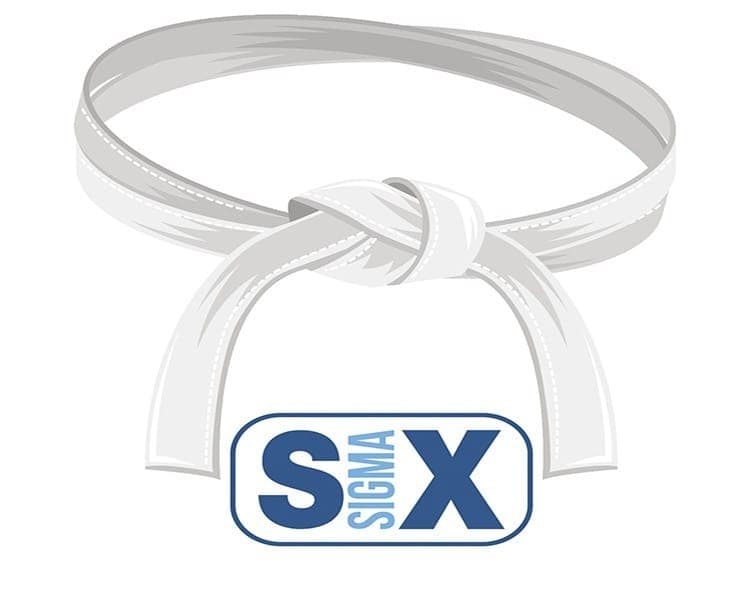Student Feedback
LSSYB: Lean Six Sigma Yellow Belt Certification Video Training Course Outline
Introduction to Lean Six Sigma Y...
Overview of Lean
Overview of Six Sigma
Overview of Continuous improveme...
The Basics of Six Sigma
General Roles and Responsibiliti...
Fundamentals of Lean and Six Sig...
The Pareto Concept (Define)
Basic Lean and Six Sigma Metrics
Selecting Six Sigma Projects
The Lean Enterprise
Systems and Methods that assist ...
Core Concepts of a Lean or Six S...
The 8 types of muda examples and...
Beginning Lean Six Sigma
Methodologies used in Lean and S...
Tools in Lean and Six Sigma
Measuring a process
Communication, Facilitation and ...
Basics of Control (Control Phase)
Key Terms used in Lean Six Sigma...
Introduction to Lean Six Sigma Yellow Belt
LSSYB: Lean Six Sigma Yellow Belt Certification Video Training Course Info
Lean Six Sigma Yellow Belt Certification Course – Boost Your Process Improvement Skills
Join the most comprehensive Lean Six Sigma Yellow Belt course available and master the skills to drive quality and operational excellence.
What you will learn from this course
Gain Lean Six Sigma Yellow Belt certification and industry-recognized credentials..
Understand how to plan, manage, and execute successful Lean Six Sigma projects.
Learn to save organizations time and money through process optimization.
Acquire proven tools and techniques to reduce errors, minimize waste, and enhance efficiency..
Develop skills to train and guide peers in Lean Six Sigma principles.
Build knowledge of the DMAIC framework, a highly demanded project management methodology.
Learn practical application of Lean Six Sigma tools in real-world business scenarios.
Develop expertise in root cause analysis, process mapping, process improvement, problem-solving, and solution development.
Enhance career prospects by demonstrating the ability to improve organizational performance.
Gain confidence in applying Lean Six Sigma methods to deliver measurable results.
Learning Objectives
Understand the core principles and concepts of Lean Six Sigma.
Identify and define key quality and process improvement metrics.
Learn the DMAIC methodology and how to apply it to real projects.
Explore Lean principles, including waste elimination, value-added processes, and process efficiency.
Understand Six Sigma methodology and its application in reducing variation and improving quality.
Learn how to incorporate customer requirements into process improvement initiatives.
Gain hands-on knowledge of project management tools, problem-solving techniques, and process analysis.
Build the ability to lead or support projects that deliver measurable business improvements.
Understand how to analyze data effectively for better decision-making and process control.
Gain a foundational skill set for continuous improvement initiatives within organizations.
Target Audience
Professionals seeking to improve business operations and process efficiency in their organizations
Managers and team leaders are responsible for operational performance and process management.
Business owners are aiming to optimize workflows and enhance quality across departments.
Employees are looking to upskill and gain a competitive advantage in their careers.
Individuals interested in project management and process improvement methodologies
Consultants who want to expand their expertise in Lean Six Sigma implementation
Anyone looking to gain certification in a highly recognized and in-demand field.
Professionals in any industry want to learn tools to reduce waste, improve quality, and save costs.s
Students and career changers looking for practical skills applicable in multiple industries
Overview
Lean Six Sigma is a methodology designed to improve processes, enhance quality, and reduce waste in organizations of all sizes. Combining the Lean approach, which focuses on eliminating inefficiencies, with Six Sigma, which aims to reduce variation and improve process quality, Lean Six Sigma equips professionals with the tools and knowledge to deliver measurable business results.
The Yellow Belt level introduces foundational concepts, enabling participants to understand process improvement principles, support projects, and gradually take on leadership roles in process optimization initiatives. This course covers key concepts, including quality management, process efficiency, DMAIC methodology, Lean principles, Six Sigma techniques, and customer focus.
Through this course, learners will gain practical insights into deploying Lean Six Sigma projects, learning both the theory and real-world applications. The knowledge gained will allow professionals to identify inefficiencies, implement improvements, and achieve measurable results that drive business growth. Lean Six Sigma is now an essential skill set across industries, with organizations increasingly valuing employees who can deliver operational excellence.
Participants will also learn the importance of aligning process improvement initiatives with organizational goals, understanding customer requirements, and applying analytical tools to measure performance. The course emphasizes a practical approach, ensuring learners can immediately apply Lean Six Sigma tools and methods within their workplace. By mastering these techniques, professionals can become change agents in their organizations, driving efficiency, quality, and continuous improvement.
Prerequisites
No prior experience in Lean Six Sigma or process improvement is required.
Basic understanding of business processes is helpful but not mandatory.
Open to all levels, from beginners to experienced professionals.s
Willingness to engage in practical exercises and apply concepts in real-world scenarios
Access to a computer and the internet for online resources, training materials, and assessments
Commitment to complete the course and apply the learning to projects within the organization
This course is structured to guide participants from the fundamentals to practical implementation, providing step-by-step learning of Lean Six Sigma Yellow Belt concepts. It introduces learners to quality management, Lean methodology, Six Sigma principles, and the DMAIC project management framework. By the end of this course, participants will understand how to contribute effectively to process improvement initiatives, reduce waste, improve quality, and deliver tangible business results.
Learners will also gain a strong foundation to pursue higher-level Lean Six Sigma certifications in the future. The knowledge and skills acquired in this course will enhance career opportunities, as Lean Six Sigma remains one of the most valued certifications for professionals in management, operations, consulting, and quality assurance. The course combines theoretical learning with practical application, ensuring participants can confidently implement Lean Six Sigma tools in any organizational environment.
By completing this course, participants will be prepared to identify inefficiencies, analyze processes, and implement solutions using proven Lean Six Sigma methodologies. This skill set enables professionals to contribute directly to organizational success, enhance team performance, and position themselves as valuable assets within their workplace. Lean Six Sigma Yellow Belt certification signifies an understanding of critical process improvement principles, providing recognition and credibility in a competitive job market.
Course Modules / Sections
The Lean Six Sigma Yellow Belt course is structured to provide a comprehensive understanding of Lean Six Sigma principles while ensuring practical application. The course is divided into multiple modules that build progressively, allowing learners to develop skills that are immediately applicable in the workplace.
The first module introduces Lean Six Sigma and its significance in modern business operations. Learners will understand the history, objectives, and benefits of Lean and Six Sigma methodologies. This module lays the foundation for understanding how process improvement can lead to measurable business results. Participants will learn about the roles and responsibilities within Lean Six Sigma projects and gain insights into the expectations at the Yellow Belt level.
The second module focuses on quality management. Quality is central to Lean Six Sigma, and learners will explore concepts such as the definition of quality, quality standards, and the importance of delivering consistent results. This module highlights how organizations can align quality initiatives with business objectives and customer requirements.
The third module introduces Lean principles in detail. Lean focuses on creating value by eliminating waste and optimizing processes. Learners will study the eight key types of waste, understand value-added versus non-value-added activities, and learn methods to streamline processes. Real-world examples will demonstrate how Lean principles can significantly improve operational efficiency.
The fourth module covers Six Sigma fundamentals. Six Sigma emphasizes reducing variation and improving process quality. Participants will learn about the statistical basis of Six Sigma, the concept of defects per million opportunities, and how process improvement impacts organizational performance. This module also explores Six Sigma roles, responsibilities, and terminology.
The fifth module is dedicated to understanding the customer. A key aspect of Lean Six Sigma is the focus on customer satisfaction. Learners will study how to capture the voice of the customer, identify critical-to-quality factors, and ensure that process improvements align with customer expectations.
The sixth module provides an in-depth exploration of the DMAIC project management framework. DMAIC – Define, Measure, Analyze, Improve, Control – is the core methodology used in Lean Six Sigma projects. Each phase will be covered in detail, with step-by-step instructions for identifying issues, analyzing processes, implementing improvements, and sustaining gains.
The seventh module focuses on Lean Six Sigma tools and techniques. Learners will gain practical knowledge of tools such as process mapping, cause-and-effect analysis, failure mode and effects analysis, control charts, and Pareto analysis. Each tool will be explained in the context of how it can improve efficiency, reduce errors, and enhance quality.
The eighth module covers project implementation and real-world applications. Participants will learn how to select projects, set goals, apply Lean Six Sigma methodologies, and track results. This module emphasizes the practical application of skills and ensures learners can translate theory into action within their organizations.
The final module addresses certification preparation and assessment. Learners will review key concepts, practice problem-solving exercises, and complete an evaluation to demonstrate their understanding. Successful completion of this module leads to a Lean Six Sigma Yellow Belt certificate, validating skills in process improvement and operational excellence.
Key Topics Covered
This Lean Six Sigma Yellow Belt course encompasses a wide range of topics essential for understanding and applying Lean Six Sigma methodologies. Topics are carefully curated to provide both foundational knowledge and practical skills.
Introduction to Lean Six Sigma: history, principles, objectives, and benefits for organizations of all sizes.
Roles and responsibilities: understanding the functions of Yellow Belts, Green Belts, Black Belts, and project sponsors.
Quality management: definition of quality, quality standards, methods to measure and improve quality, and aligning quality with organizational goals.
Lean methodology: identification of the eight wastes (defects, overproduction, waiting, non-utilized talent, transportation, inventory, motion, extra-processing), value-added versus non-value-added steps, and techniques to enhance efficiency.
Six Sigma principles: statistical foundations, reducing process variation, understanding defects per million opportunities, and applying Six Sigma in real projects.
Customer focus: capturing the voice of the customer, identifying critical-to-quality factors, and ensuring improvements meet customer expectations.
DMAIC framework: detailed guidance on Define, Measure, Analyze, Improve, Control phases, including tools, techniques, and best practices for each stage.
Process improvement tools: process mapping, value stream mapping, root cause analysis, cause-and-effect diagrams, Pareto charts, and control charts.
Project selection and implementation: identifying high-impact projects, setting objectives, applying Lean Six Sigma techniques, and measuring results.
Continuous improvement: principles of Kaizen, sustaining improvements, and fostering a culture of ongoing process optimization.
Data analysis: interpreting data to identify trends, monitor performance, and make informed decisions for process improvements.
Risk management: identifying potential risks in processes, assessing impact, and implementing controls to mitigate them.
Communication and stakeholder management: engaging teams, reporting progress, and ensuring alignment with organizational goals.
Certification preparation: practice exercises, review of core concepts, and assessment for Lean Six Sigma Yellow Belt credentialing.
Teaching Methodology
The Lean Six Sigma Yellow Belt course employs a combination of teaching methods to ensure learners gain both theoretical knowledge and practical skills. The methodology is designed to be interactive, engaging, and applicable to real-world scenarios.
Learning begins with video lectures and presentations that explain fundamental concepts in an easy-to-understand format. These sessions cover the history, principles, and tools of Lean Six Sigma, providing a solid foundation for practical application. Visual aids, diagrams, and examples are used to simplify complex topics and enhance understanding.
Practical exercises are integrated throughout the course to reinforce learning. Participants will engage in simulations, case studies, and scenario-based exercises that replicate real organizational challenges. This approach ensures learners can apply Lean Six Sigma methodologies in a controlled environment before implementing them in their workplace.
Interactive quizzes and assessments are provided after each module to evaluate comprehension and retention. Immediate feedback helps learners identify areas for improvement and ensures mastery of key concepts.
Supplementary resources, such as downloadable guides, templates, and toolkits, are provided to support hands-on learning. These resources allow participants to practice Lean Six Sigma tools, create process maps, conduct root cause analyses, and develop improvement plans.
Instructor-led sessions or discussion forums encourage collaboration and knowledge sharing. Learners can ask questions, discuss challenges, and receive guidance from experienced Lean Six Sigma practitioners. This collaborative approach fosters a deeper understanding of concepts and encourages the exchange of best practices.
Project-based learning is a core component of the methodology. Participants are guided through a full Lean Six Sigma project lifecycle, from problem identification to solution implementation and performance measurement. This practical experience ensures learners gain confidence in applying Lean Six Sigma tools and methodologies effectively.
The course also emphasizes continuous improvement and reflection. Learners are encouraged to evaluate their own processes, identify inefficiencies, and implement solutions in their personal or professional environment. This approach ensures the skills learned are transferable and immediately valuable.
Assessment & Evaluation
Assessment and evaluation are integral parts of the Lean Six Sigma Yellow Belt course, ensuring participants have mastered the concepts and can apply them effectively. The assessment process combines multiple methods to measure knowledge, practical skills, and project application.
Module quizzes test theoretical understanding of Lean Six Sigma principles, Lean methodology, Six Sigma concepts, quality management, and the DMAIC framework. These quizzes are designed to reinforce learning, provide immediate feedback, and highlight areas that may require additional study.
Practical exercises and case studies assess the ability to apply Lean Six Sigma tools in real-world scenarios. Participants will complete exercises involving process mapping, root cause analysis, and the application of improvement techniques. These activities help learners develop hands-on skills and demonstrate competency in problem-solving and project execution.
Project evaluation forms a significant part of the assessment. Learners will be guided through a project using the DMAIC methodology, from defining the problem to implementing solutions and measuring outcomes. The evaluation criteria include the ability to apply Lean Six Sigma principles, the effectiveness of solutions implemented, and the clarity of documentation and reporting.
Final certification assessment evaluates overall comprehension and practical application. Successful completion confirms that participants have acquired the knowledge and skills necessary to support or lead Lean Six Sigma projects at the Yellow Belt level. Certification validates proficiency in process improvement, operational efficiency, and problem-solving.
Continuous feedback throughout the course helps learners track progress, identify strengths, and address weaknesses. This structured evaluation ensures participants gain confidence and competence in applying Lean Six Sigma methodologies effectively.
By completing the assessments and evaluations, learners will not only earn certification but also gain practical skills to deliver measurable improvements in their organizations. These skills are highly valued across industries, making certified Yellow Belts essential contributors to process optimization, quality enhancement, and operational excellence.
Benefits of the Course
The Lean Six Sigma Yellow Belt course offers numerous benefits for professionals across industries, enhancing career prospects and providing practical skills for operational excellence. One of the primary benefits is the acquisition of an industry-recognized certification, which validates your ability to apply Lean Six Sigma methodologies to real-world projects. This credential demonstrates to employers that you possess the knowledge and skills to drive process improvements, reduce waste, and enhance quality.
Participants gain a deep understanding of process efficiency, quality management, and project management principles. By mastering Lean Six Sigma concepts, learners can identify inefficiencies, implement effective solutions, and deliver measurable results that contribute directly to organizational success. This knowledge positions participants as valuable assets in their workplace, capable of making data-driven decisions and optimizing processes.
The course also develops critical thinking and problem-solving skills. Lean Six Sigma Yellow Belts are trained to analyze processes, identify root causes of issues, and implement targeted improvements. This analytical approach enables participants to approach challenges systematically, improving both efficiency and decision-making within their teams.
Another key benefit is the ability to lead or support Lean Six Sigma projects. Participants will learn to apply the DMAIC framework, understand the roles and responsibilities within project teams, and use Lean Six Sigma tools effectively. This practical experience ensures that learners can contribute to projects from start to finish, whether in operational, managerial, or consultancy roles.
The skills gained in this course are highly transferable across industries. Whether in manufacturing, healthcare, IT, finance, or service-based organizations, the principles of Lean Six Sigma can be applied to enhance processes, reduce errors, and improve overall performance. Professionals equipped with Yellow Belt certification are increasingly in demand as organizations prioritize efficiency, quality, and cost-effectiveness.
Participants also benefit from enhanced career opportunities. Certification in Lean Six Sigma provides a competitive advantage, opening doors to promotions, new roles, or specialized projects within organizations. Additionally, the course fosters a culture of continuous improvement, encouraging learners to consistently seek ways to optimize processes and deliver higher value to their teams and customers.
Beyond career benefits, the course equips participants with practical tools and techniques to improve everyday business processes. From process mapping to root cause analysis and control chart interpretation, learners gain hands-on experience with proven methods that can be applied immediately in the workplace. This ensures that the benefits of the course are both tangible and long-lasting.
Finally, the course promotes personal development by enhancing confidence in applying structured problem-solving techniques. Participants will be able to communicate improvement strategies effectively, lead initiatives with authority, and demonstrate measurable results, establishing themselves as capable professionals in the eyes of colleagues and employers.
Course Duration
The Lean Six Sigma Yellow Belt course is designed to accommodate a range of learning schedules while ensuring comprehensive coverage of all essential topics. The total duration of the course is typically 20 to 25 hours of structured learning, which can be completed over a few weeks depending on the learner’s pace and availability.
The course is divided into multiple modules, each focusing on specific aspects of Lean Six Sigma. Learners can progress through the modules sequentially, building knowledge and skills in a logical, step-by-step manner. Each module includes video lectures, reading materials, practical exercises, and assessments to reinforce learning.
Flexibility is a key feature of the course duration. Participants can access content online at any time, allowing them to balance learning with professional and personal commitments. The modular design ensures that learners can pause and resume their training as needed, making it suitable for both full-time professionals and those with limited availability.
The duration also includes practical exercises and case studies to provide hands-on experience. These activities simulate real-world scenarios, enabling learners to apply Lean Six Sigma tools and techniques in a controlled environment. This practical approach ensures that participants gain not only theoretical knowledge but also actionable skills.
Assessment and evaluation are incorporated into the course duration, allowing learners to track progress and measure competency. Quizzes, exercises, and project-based evaluations are spaced throughout the course, ensuring that participants can internalize concepts and apply them effectively before moving to subsequent modules.
Overall, the course duration is carefully designed to balance comprehensive coverage of Lean Six Sigma concepts with practical, hands-on learning. By the end of the program, participants will have gained the knowledge, skills, and certification needed to contribute effectively to process improvement initiatives in any organization.
Tools & Resources Required
To complete the Lean Six Sigma Yellow Belt course, participants will need access to a few essential tools and resources. These tools are designed to facilitate learning, support practical exercises, and enhance the overall training experience.
A computer or laptop with internet access is required to access online lectures, reading materials, and interactive exercises. The course platform provides all necessary digital resources, including video tutorials, slides, templates, and case studies, which can be accessed at any time during the training.
Participants will also benefit from software tools commonly used in Lean Six Sigma projects. Spreadsheet programs such as Microsoft Excel or Google Sheets are useful for data analysis, process mapping, and project tracking. Basic familiarity with these tools is sufficient, and the course guides how to apply them effectively for Lean Six Sigma purposes.
Access to a note-taking system or digital document editor is recommended to record insights, observations, and project plans. Documenting processes, improvements, and results is a critical part of Lean Six Sigma, and maintaining organized records supports both learning and practical application.
Templates and guides provided within the course serve as valuable resources for applying Lean Six Sigma tools. These may include process mapping templates, DMAIC project templates, control chart guides, and root cause analysis worksheets. Using these resources allows participants to practice techniques and implement improvements with confidence.
For interactive exercises and assessments, learners may need access to collaboration tools such as email or team communication platforms. These tools facilitate communication with instructors, peer discussions, and submission of project assignments where applicable.
Optional resources include access to additional reference materials, such as Lean Six Sigma books, online articles, and industry case studies. While not mandatory, these resources can deepen understanding and provide practical examples of Lean Six Sigma applications across different industries.
By combining digital learning materials, practical templates, and essential software tools, participants will be fully equipped to complete the course successfully. These resources ensure that learners can apply Lean Six Sigma principles effectively, both during the course and in real-world organizational settings.
In summary, the Lean Six Sigma Yellow Belt course provides all the necessary resources for a successful learning experience. From video lectures and guides to practical templates and software tools, participants have everything they need to gain knowledge, develop skills, and achieve certification. By leveraging these tools, learners can confidently implement process improvement initiatives, enhance operational efficiency, and deliver measurable results in any professional environment.
Career Opportunities
Completing the Lean Six Sigma Yellow Belt course opens a wide array of career opportunities across industries. Professionals with Yellow Belt certification are highly valued for their ability to identify process inefficiencies, reduce errors, and implement cost-saving initiatives. Organizations seek individuals who can contribute to operational excellence, making Yellow Belt holders essential assets in corporate, manufacturing, healthcare, IT, and service sectors.
Entry-level positions often include roles such as process improvement analyst, operations assistant, quality assurance coordinator, or project support specialist. In these roles, Yellow Belt professionals support Lean Six Sigma projects, gather and analyze data, assist in process mapping, and implement improvement initiatives under the guidance of Green or Black Belt practitioners.
For mid-level professionals, Yellow Belt certification enhances leadership potential. Managers, team leaders, and department heads can leverage their understanding of Lean Six Sigma principles to streamline operations, improve quality, and enhance customer satisfaction. Knowledge gained in the course equips these professionals to identify high-impact projects, monitor performance metrics, and drive continuous improvement within their departments.
Consulting roles also benefit from Yellow Belt certification. Process improvement consultants and operational efficiency advisors are increasingly in demand as organizations look to implement Lean Six Sigma frameworks. Professionals with Yellow Belt expertise can contribute to client engagements, support project teams, and provide recommendations for process optimization, quality improvement, and cost reduction.
In addition, Yellow Belt certification provides a strong foundation for further advancement in Lean Six Sigma. Professionals can progress to Green Belt, Black Belt, or Master Black Belt levels, unlocking higher-level opportunities such as project leadership, process excellence management, and organizational strategy roles. Career advancement is accelerated by the practical skills and recognized certification provided through this course.
Industries including manufacturing, finance, healthcare, information technology, logistics, and service sectors increasingly value Lean Six Sigma expertise. Yellow Belt holders are equipped to contribute to quality improvement, waste reduction, and process standardization initiatives, providing measurable results that benefit both employees and the organization. Professionals trained in Lean Six Sigma principles are also better positioned for roles in operational management, quality assurance, project coordination, and strategic process improvement.
Beyond industry-specific roles, Lean Six Sigma Yellow Belt certification also benefits entrepreneurs and business owners. The skills gained enable business leaders to optimize workflows, improve operational efficiency, and enhance customer satisfaction. By implementing Lean Six Sigma principles internally, entrepreneurs can drive growth, minimize waste, and create a culture of continuous improvement within their organizations.
Furthermore, Yellow Belt holders often find opportunities in cross-functional teams and transformation initiatives. Organizations value individuals capable of analyzing processes across departments, identifying inefficiencies, and implementing sustainable solutions. This cross-functional expertise enhances career versatility and provides opportunities to work on high-impact projects that influence organizational strategy.
The course also enhances professional credibility and marketability. Lean Six Sigma Yellow Belt certification is recognized globally, signaling to employers, clients, and colleagues that the holder possesses essential skills in process improvement and operational efficiency. This recognition increases career mobility, opens doors to new roles, and provides a competitive advantage in professional advancement.
Conclusion
The Lean Six Sigma Yellow Belt course equips professionals with the knowledge, skills, and certification necessary to drive process improvements and operational excellence. Participants gain a thorough understanding of Lean principles, Six Sigma methodology, DMAIC project management, and practical tools for identifying inefficiencies, reducing errors, and enhancing quality.
By completing this course, learners develop critical thinking, analytical skills, and the ability to apply structured problem-solving techniques in any professional environment. These competencies are in high demand across industries, enabling participants to contribute effectively to organizational success, streamline processes, and create measurable value.
The course provides both theoretical knowledge and practical experience, ensuring learners can confidently support or lead Lean Six Sigma projects. Through modules covering quality management, Lean methodology, Six Sigma principles, customer focus, process improvement tools, and project implementation, participants acquire a comprehensive skill set that is immediately applicable in the workplace.
Certification in Lean Six Sigma Yellow Belt enhances career prospects, offering opportunities for roles in process improvement, operations, quality assurance, consulting, and management. The skills acquired are transferable across industries, making participants valuable assets in manufacturing, healthcare, IT, finance, logistics, and service sectors.
Additionally, the course fosters a mindset of continuous improvement, enabling participants to identify inefficiencies, implement sustainable solutions, and drive operational excellence. By mastering Lean Six Sigma tools and methodologies, learners can contribute to organizational growth, improve customer satisfaction, and achieve measurable results that positively impact performance and profitability.
Lean Six Sigma Yellow Belt certification also provides a foundation for further professional development. Participants can progress to Green Belt, Black Belt, or Master Black Belt levels, unlocking advanced career opportunities in process excellence, project leadership, and strategic organizational roles. The certification signals expertise, credibility, and the ability to implement high-impact process improvements, making holders highly sought after in today’s competitive job market.
Overall, this course empowers professionals to enhance efficiency, quality, and performance within their organizations. By combining theoretical knowledge with practical application, participants gain the confidence and skills needed to make meaningful contributions, optimize operations, and achieve measurable business outcomes. Lean Six Sigma Yellow Belt certification is a valuable credential that demonstrates expertise, drives career growth, and provides a competitive advantage in a wide range of industries.
Enroll today
Take the next step in advancing your career by enrolling in the Lean Six Sigma Yellow Belt course. Gain the knowledge, practical skills, and recognized certification needed to implement process improvements, reduce waste, and enhance quality across any organization. Develop expertise in DMAIC methodology, Lean principles, Six Sigma tools, and problem-solving techniques that are highly valued across industries.
Enroll today to start your journey toward becoming a certified Lean Six Sigma Yellow Belt and position yourself as a skilled professional capable of driving measurable improvements, operational efficiency, and excellence within your organization.













